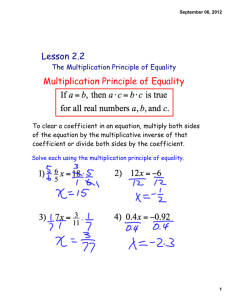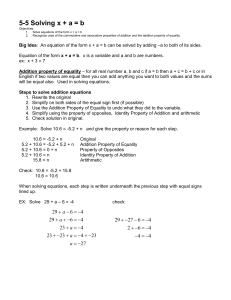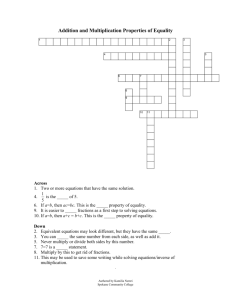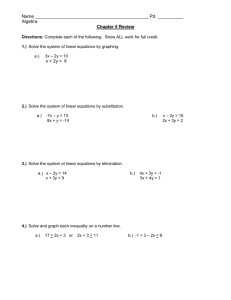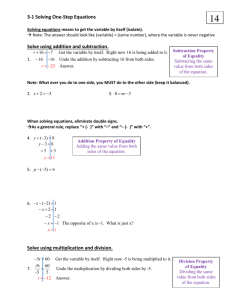Unit 2
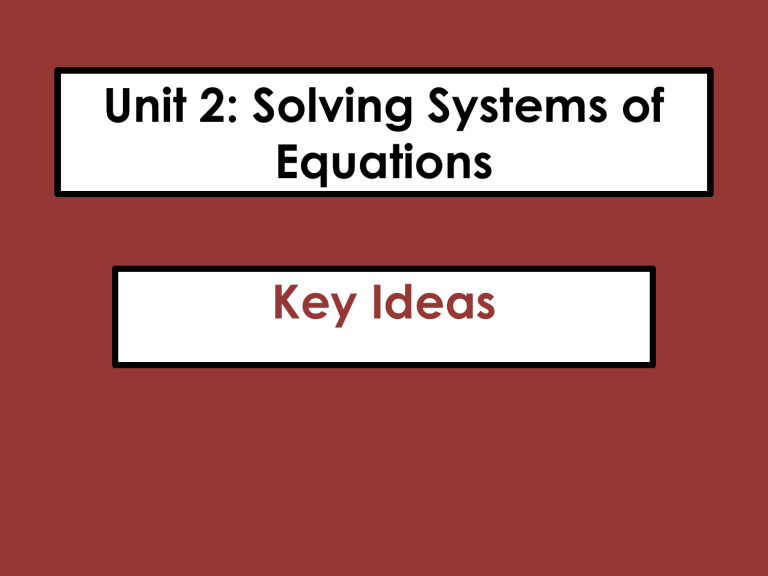
Unit 2: Solving Systems of
Equations
Key Ideas
Summary of Methods
1)Substitution: Requires that one of the variables be isolated on one side of the equation. It is especially convenient when one of the variables has a coefficient of 1 or -1.
2)Elimination: Can be applied to any system, but it is especially convenient when a variable appears in different equations with coefficients that are opposites.
3)Graphing: Can provide a useful method for estimating a solution.
Solve the given system by substitution:
1) 2x – y = 7
3x + 3y = - 3
Solve the given system by elimination:
2) -3x + 4y = -4
3x – 6y = 6
Reasoning with Equations & Inequalities
• Understanding how to solve equations
• Solve equations and inequalities in one variable
• Solve systems of equations
• Represent and solve equations and inequalities graphically.
Important Tips
• Know the properties of operations
• Be familiar with the properties of equality and inequality. (Watch out for the negative multiplier.)
• Eliminate denominators (multiply by denominators to eliminate them)
Properties to know
• Addition Property of Equality
• Subtraction Property of Equality
• Multiplication Property of Equality
• Division Property of Equality
• Reflexive Property of Equality
• Symmetric Property of Equality
• Transitive Property of Equality
• Commutative Property of Addition and
Multiplication
• Associative Property of Addition and Multiplication
• Distributive Property
• Identity Property of Addition and Multiplication
• Multiplicative Property of Zero
• Additive and Multiplicative Inverses
Example 1
Solve the equation 8(x + 2) = 2(y + 4) for y.
Example 2
Karla wants to save up for a prom dress.
She figures she can save $9 each week from the money she earns babysitting.
If she plans to spend up to $150 for the dress, how many weeks will it take her to save enough money?
17weeks
Example 3
• This equation can be used to find h, the number of hours it takes Bill and
Bob to clean their rooms.
h
h
5 20
1
• How many hours will it take them?
Example 4
• You are selling tickets for a basketball game.
Student tickets cost $3 and general admission tickets cost $5. You sell 350 tickets and collect $1450.
• Use a system of linear equations to determine how many student tickets you sold?
Student : x
General : y
150 student
Example 5
You sold 52 boxes of candy for a fundraiser.
The large size box sold for $3.50 each and the small size box sold for $1.75 each. If you raised $112.00, how many boxes of each size did you sell?
large : x small : y
A. 40 large, 12 small
B. 12 large, 40 small
C. 28 large, 24 small
D. 24 large, 28 small
Example 6
You sold 61 orders of frozen pizza for a fundraiser. The large size sold for $12 each and the small size sold for $9 each.
If you raised $660.00, how many of each size did you sell?
large : x small : y
A. 24 large, 37 small
B. 27 large, 34 small
C. 34 large, 27 small
D. 37 large, 24 small
Example 7
Which equation corresponds to the graph shown?
A. y = x + 1
B. y = 2x + 1
C. y = x – 2
D. y = -3x – 2
Example 8
Which graph would represent a system of linear equations that has no common coordinate pairs?
A B
C D
Ex. 9 Graph
x 4
2
